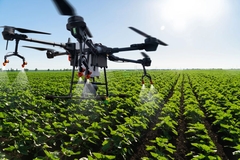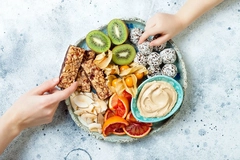Underutilized jackfruit tipped as “future superfood” but only if production and post-harvesting improve
23 Feb 2023 --- Deterioration of jackfruit quality during storage and transport limits the ingredient, nutritional and market potential of the fruit, according to a review of its phytonutrient profile and post-harvest quality management. The highly versatile fruit is a source of carbohydrates, protein, fiber, vitamins, minerals and several phytochemicals.
NutritionInsight speaks with one of the study’s authors and Dutch company Fairtrade Original about jackfruit’s potential.
Professor Zora Singh at Edith Cowan University, Australia, notes that with intensive research on jackfruit production and post-harvesting practices, the fruit “can become the future ‘superfood’ to fulfill the nutritional needs of the growing world population due to its high medicinal value and excellent nutritional composition.”

Additionally, improving these systems can have lasting effects on local economies, highlights Lisette Brouwers, product manager of food at Fairtrade Original. Brouwers notes that when the company started sourcing young jackfruit from Thailand, it was a welcome addition for the area’s farmers.
Before, farmers harvested smaller fruits to allow other fruits to grow, which were consumed at home. Only mature jackfruit was sold on local markets. Fairtrade Original introduced canned young jackfruit pieces in 2019 and pulled young jackfruit in 2021.
“This new market for the young jackfruits made it possible for the farmers to expand their business and enhance their financial situation.”
.png) Demand for nutritious and versatile jackfruit is growing, for example, as an alternative to meat. (Image credit: Fairtrade Original). Product innovations
Demand for nutritious and versatile jackfruit is growing, for example, as an alternative to meat. (Image credit: Fairtrade Original). Product innovations
Jackfruit (Artocarpus heterophyllus) is the largest fruit grown worldwide in tropical and subtropical regions.
The authors explain that several products can be prepared from jackfruit rind, seeds and (unripe) fruit. Products include jam, fermented beverages, dried jackfruit, preserves, candy, chips and juice.
Jackfruit pulp is used to flavor beverages and ice cream, while the seeds have potential in flour production due to their high protein and amylose content. Also, jackfruit starch could be used as a medicine carrier, a binding agent or an emulsifier and has potential for meat alternatives.
An underutilized crop
Demand for jackfruit is growing. Brouwers notes that “more brands are offering jackfruit in the market and jackfruit-derived products are being developed.”
However, according to Singh, it is still an underutilized fruit crop.
He notes that no identified superior jackfruit genotypes exist. Instead, cultivars are known by different local names, making it difficult to commercialize the crop.
Moreover, only 30-35% of the fruit is edible. The rest, seeds, peel, rag and core, are considered waste and consumers might dislike the fruit as “the intense fruit aroma is unbearable to some people,” notes Singh.
There is also “no uniformity among the fruits in size, shape, fruit and pulp color and fruit firmness, which further results in difficulty in fruit marketing.”
The fruit’s large size makes fruit handling and post-harvest operations challenging.
Plant-based diet
Brouwers emphasizes the fruit’s potential in meat alternatives. Although young jackfruit does not meet the protein values of meat replacers, “the bite and appearance make young jackfruit a well-loved meat alternative.”.jpg) Brouwers explains that the young jackfruits Fairtrade Original sources are “picked and processed within 24 hours.” (Image credit: Fairtrade Original).
Brouwers explains that the young jackfruits Fairtrade Original sources are “picked and processed within 24 hours.” (Image credit: Fairtrade Original).
“When pulses, nuts or other plant-based ingredients high in protein are consumed throughout the day, young jackfruit fits well into a plant-based diet. The future generations will be more familiar with plant-based as such and do not seek so much the shape and taste of meat,” notes Brouwers.
“This allows plant-based products like pulses, jackfruit or banana blossom to become more interesting than the processed meat replacers.”
Harvesting and post-harvest handling
Post-harvest losses occur due to mechanical injuries, moisture loss, fruit rot, uneven ripening, chilling injury and metabolic processes such as ethylene production and respiration. As the fruit is highly perishable, it has a short storage life.
Singh suggests that companies working with jackfruit should adhere to “proper harvesting and post-harvest practices including handling, transportation, fruit storage and utilization of already proven and novel techniques for fruit storage and processing.”
He notes that these practices can facilitate the exportation of jackfruit by extending its shelf life.
Brouwers explains that the young jackfruit Fairtrade Original sources are soaked in water and brine to avoid discoloration when peeling and cutting.
“The farmers are located close to the canning factory, which enables them to process the fruits within 24 hours after harvest. This is necessary to ensure the fruit’s freshness and prevent the rotting process from taking over.”
Singh suggests companies use non-edible parts to add value to jackfruit. “Jackfruit waste such as peel, seed, core and rag is a ‘blessing in disguise’ for the processing industries due to their nutritional importance.” .png) Singh suggests that producers should adhere to “proper harvesting and post-harvest practices.” (Image credit: Zora Singh).
Singh suggests that producers should adhere to “proper harvesting and post-harvest practices.” (Image credit: Zora Singh).
Brouwers echoes this, saying, “We are always looking for more opportunities, either in new types of fruits or combinations of the Jackfruit with our sauces.”
Research gaps
The study, published in Critical Reviews in Food Science and Nutrition, outlines several research gaps for fruit maturity, ripening and the impact of various post-harvest strategies on fresh and fresh-cut fruit. If a grower has little experience harvesting jackfruit, they might harvest immature or overmature fruits of poor quality.
As a first step to fill these gaps and to reduce post-harvest losses, Singh suggests that an advanced yet simple technique, backed by scientific research, should be developed to optimize fruit maturity in jackfruit, as well as exploring different methods that have shown promising results in fruit handling and storing other fruit.
By Jolanda van Hal






.png)






